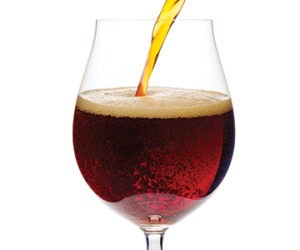Milkshake IPA: Tips from the Pros
Brewer: Michael Tonsmeire, Sapwood Cellars in Columbia, MD
Milkshake IPA is one of the latest adaptations in the Specialty IPA category, but many would argue against this nomenclature. With very subdued hop bitterness, strong fruit character from copious amounts of late-boil and dry hops along with the addition of such ingredients as lactose sugar, vanilla beans, various fruit additions, and (gasp!) raw flour — the Milkshake IPA has emerged as a beer as unique and polarizing among craft beer enthusiasts as they come. So let’s explore what it takes to brew this style.
Milkshake IPAs aren’t about subtlety or sessionability; the best ones are creamy explosions of fruit and hops! The hops and fruit should push the flavor in the same direction rather than fighting for dominance. For example: Centennial/orange, Motueka/lime, Simcoe®/mango, Amarillo®/apricot, GalaxyTM/passion fruit etc. The result should be a wave of saturated fruitiness on the palate! The yeast can accentuate those flavors too, like Omega HotHead for orange, Conan for peach, or White Labs Sacch Trois for pineapple. Otherwise select a strain that is popular for the hazy New England-style IPAs, like Wyeast London Ale III, White Labs English Dry Ale, or Safale S-04.
I keep the malt bill simple: American 2-row brewer’s malt, with 20% flaked oats or wheat. You can add 5% light crystal malt or honey malt to increase the perception of sweetness; this is beneficial if you don’t plan to add any lactose. Mash between 156-158 °F (69-70 °C) to balance the simple sugars provided by the fruit. I don’t add anything with the sole intention of increasing haze such as flour, instead focusing on flavor and mouthfeel.
Keep the bitterness to a minimum, especially because the fruit will lower the pH of the finished beer, accentuating the bitterness. Focus on late-boil and post-boil hopping, skipping the 60-minute bittering addition entirely. This is a good opportunity to slightly cool the wort post-boil to 170-190 °F (77-88 °C) with an immersion chiller to reduce isomerization before starting the whirlpool or hop-stand. I prefer mid-fermentation dry hop additions to post-fermentation because active yeast can scrub the rawer hop notes, muting them but leaving a fruiter impression. Don’t be shy, 1 oz./gallon (7.5 g/L) for hot and cold side hop additions is totally reasonable. A second small dry hopping a couple days before packaging can replace what has faded during the secondary fermentation on fruit.
I add the split vanilla bean at the end of fermentation. In 5 gallons (19 L) half a vanilla bean is subtle, and one is assertive. You can dose the beer with vanilla extract at packaging if it needs a boost.
Fruit processing is a personal choice, but I prefer zest for citrus (use a vegetable peeler, scraping with a spoon to remove any white pith attached to the colorful strip of zest). I save the best local in-season fruit to showcase in sour beers. As a result, my hoppy non-citrus fruit beers receive frozen or pureed fruit. Again, don’t be shy with how much you add!
Even if you aren’t vegan or lactose-intolerant wait to add lactose until bottling or kegging, and do so to taste. I’ve tasted a few milkshake IPAs that tease me with a wonderful aroma, followed by a syrupy sweetness from lactose pushing the final gravity above 1.030. This is especially common in “double” versions. The low bitterness and perceived sweetness from fruit and vanilla may be enough. For added creaminess you can even serve on beer gas (nitrogen and carbon dioxide) through a stout faucet!
Brewer: Rowan Chadwick, Urban Family Brewing Co. in Seattle, WA
Just like any beer, balance is key, there are many different ingredients going into our ‘-Sicle’ series beers. Too much lactose or vanilla and the beer can become cloying, too many dry hops and it can get too bitter (yes even dry hopping can add IBUs!) Finally some fruits can be quite acidic. We don’t add any flour or apples to the boil for our beers. Trial and experimentation is the key to success and to making your own, unique creation.
Ingredients are one area where it really is up to you and your tastes! Choose your favorite fruit(s), your favorite dry hop(s), and experiment! More tropical hops work well and tropical fruit can be good too but don’t let that stop you from trying things outside the box. Just because something hasn’t been tried before (as far as you know) doesn’t make it a bad idea. Find great ingredients you love, get them fresh and if possible from small, local suppliers and you might just create something magical!
To detractors who take offense to the idea behind this style, I say, to each their own! I’m a part of the population that hates cilantro, that doesn’t mean I’m going to get upset if you put it in a taco, we all have different tastes, embrace and enjoy that, don’t fight against it.



